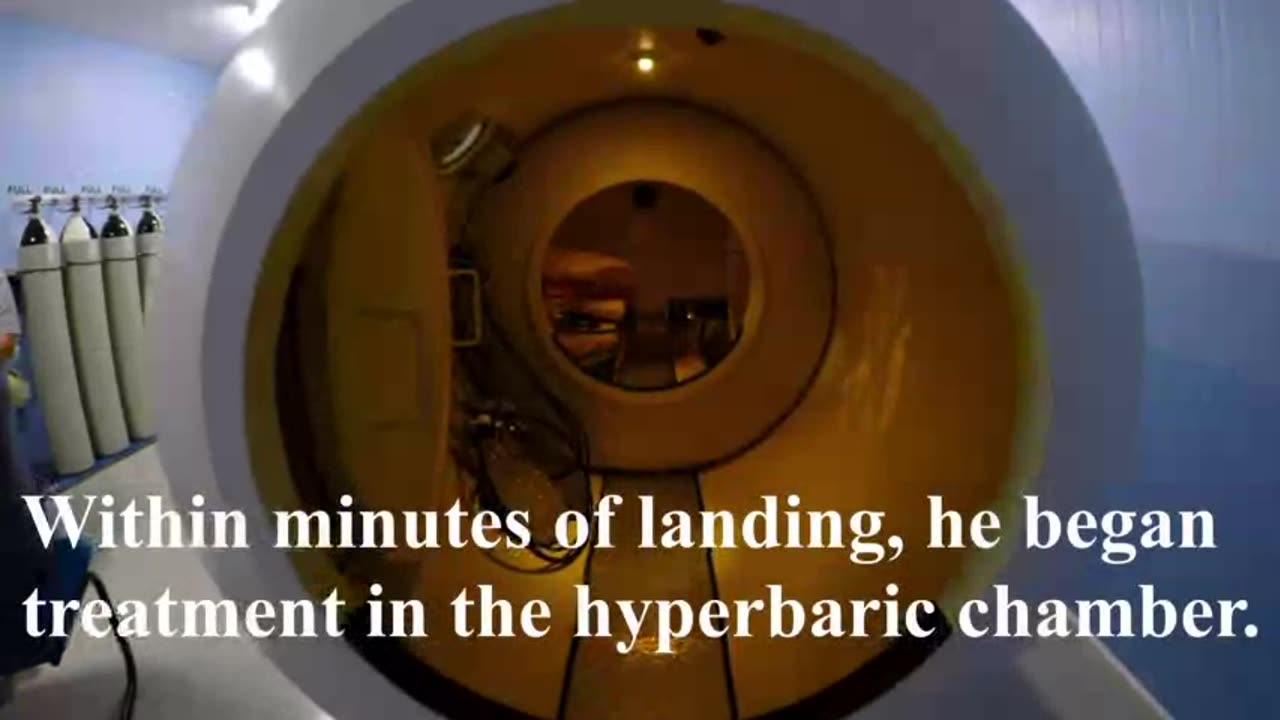Premium Only Content

Scuba diver documents his life-saving treatment in hyperbaric chamber
Scuba diving is an extremely safe sport when procedures and guidelines are followed carefully. But even seasoned divers occasionally make errors. In rare cases, those errors can be dangerous, or even fatal. Dave is a diver who documented his experience in Papua New Guinea. He had a very close call and he was lucky to survive this experience.
While exploring the remote islands in Kimbe Bay, PNG, Dave took part in several group dives each day. The entire group used reliable computers and followed their dive guide. Dave was careful to watch his depth and he carefully ascended after each dive, making sure he came to the surface slowly enough to avoid decompression illness (the bends). But while the other divers on the boat skipped occasional dives, Dave didn't miss any. The result was an accumulation of nitrogen in his blood that eventually caught up with him. His dive computer did not indicate any potential problems. He fully believed that he was diving conservatively enough to avoid the bends.
The footage of the shark took place at a depth of 22m (70 feet). After 45 minutes, the group ascended carefully. The divers had all accumulated nitrogen while under pressure. But Dave had more than a safe level and the gas created bubbles in his blood stream as the pressure lessened.
As he climbed back onto the boat, he began to feel abdominal pain. He experienced nausea and confusion soon after getting out of his wetsuit. His hands and feet were going numb. When he had vision difficulty a few minutes later, he realized he had a serious problem. By now, all he could manage to do was to lie down. Dave's wife and Mark, the tour leader recognized immediately that he was suffering from decompression illness and that he was declining rapidly. By now, his vision was blurred and he was having speech difficulty. They quickly administered oxygen and prepared for an emergency evacuation.
Mark began making calls to the Diver's Alert Network, an insurance organization that provides emergency care in incidents such as this one. Captain Alan changed course and headed for shore. The nearest hyperbaric chamber was in Port Moresby, several hours away by jet.
Dave was transported by land ambulance to the airport where he was met by Dr. Bobby, the hyperbaric physician, and the pilot. Within minutes, Dave was flown to the chamber. The jet cabin was pressurized to mimic sea level. Nitrogen bubbles in a diver's bloodstream pose a serious danger. They can cause a stroke, brain damage, heart attacks, and paralysis. The symptoms in this case indicated that bubbles were present in Dave's brain and spinal cord. He was at risk of suffering neurological damage and life-threatening complications.
When the jet landed, it taxied to the door of the hyperbaric chamber. Dave was unable to walk without assistance. After a very quick introduction to the hyperbaric team, Dave was put inside the chamber and the steel door closed behind him. A technician accompanied him and remained in the chamber throughout the six hour procedure. The chamber was pressurized quickly to mimic a depth of 20m (62 feet). The pressure decreases the bubbles in the bloodstream, lessening the risk of stroke and other problems. It also causes a great improvement in the symptoms that Dave had been feeling. But pressure causes the body to accumulate more nitrogen. To prevent this, Dave and the technician were given pure oxygen at precise intervals.
Over the next six hours, pressure was carefully controlled and slowly decreased to simulate a slow and precise ascent from depth. This allows a diver to expel nitrogen through respiration. The controlled reduction in pressure prevents bubbles from forming. By the time pressure was normalized and the door opened, Dave felt much improved.
Dr. Bobby and the hyperbaric team have extensive training and great skill. They treat divers from several countries in the South Pacific. They carefully monitored Dave for 4 days after treatment to ensure that his symptoms had been fully resolved. Any recurrence of medical trouble would require a second treatment in the chamber. After 4 days, Dr. Bobby cleared Dave for a flight home. To fly at altitude would create serious risk if a patient has not fully recovered.
Dave has many people to thank for saving his life. His wife Kristy, Mark Strickland, Capt. Alan Raabe , Dr. Bobby, the Port Moresby Hyperbaric Team, and the late Max Benjamin for making things happen smoothly. He is also grateful to D.A.N. for providing high quality medical care.
After returning home, Dave met with a scuba doctor who made it clear that he had a very close call. Dave continues to dive, but much more cautiously. He has also learned to not place excessive trust in dive computers.
-
 1:10:46
1:10:46
The Rubin Report
3 hours agoLEAKED: Tense Meeting Details Leaked as MSNBC Lays Off Major Hosts
66.5K104 -
 1:03:25
1:03:25
Timcast
4 hours agoDAN BONGINO Named Deputy FBI Director Under Kash Patel, Deep State & Dem IN PANIC | Timcast LIVE
233K91 -
 2:31:41
2:31:41
Steven Crowder
5 hours ago🔴 Trump Drops a Bombshell: Bongino’s FBI Takeover & Crowder in Germany Exclusive
665K259 -
 1:59:34
1:59:34
LFA TV
23 hours agoTIME FOR PAYBACK! | LIVE FROM AMERICA 2.24.25 11AM
115K17 -
![🔴[LIVE TRADING] Bounce or Bust?! || The MK Show](https://1a-1791.com/video/fwe2/ad/s8/1/c/n/q/f/cnqfy.0kob-small-The-MK-Show-Feb.-24th.jpg) DVR
DVR
Matt Kohrs
16 hours ago🔴[LIVE TRADING] Bounce or Bust?! || The MK Show
73.7K2 -
 1:03:25
1:03:25
Kyle Fortch
5 hours ago $2.47 earnedRick Barker: Managing & Developing Taylor Swift, Breaking Artists Today & MORE | THE ONE SHEET S1E5
98.6K1 -
 37:11
37:11
BonginoReport
7 hours agoDan Bongino is Leaving (Ep.146) - 02/24/2025
248K475 -
 2:59:20
2:59:20
Wendy Bell Radio
8 hours agoThe MAGA Diet
182K61 -
 1:22:03
1:22:03
Graham Allen
6 hours agoGRAHAM MAKES YUGE ANNOUNCEMENT!! + LIBERAL REP ROOTING AGAINST AMERICA?!
111K115 -
 1:01:28
1:01:28
Randi Hipper
4 hours agoETHEREUM PRICE BOUNCES AFTER BILLION DOLLAR HACK!
40K1